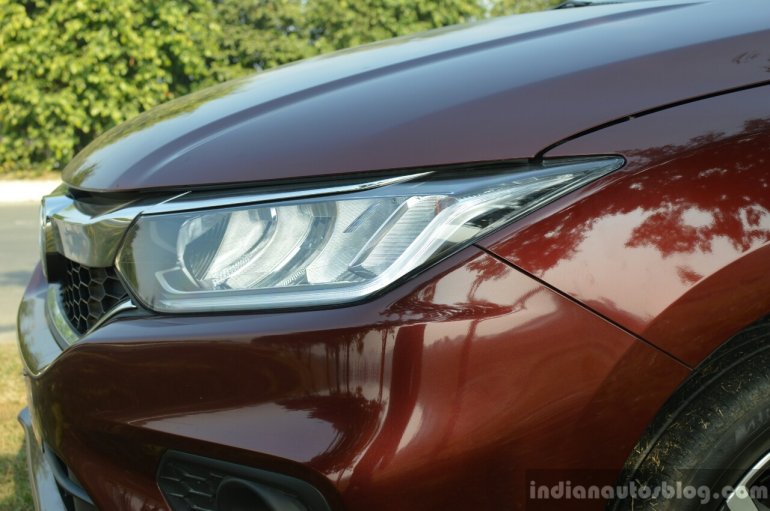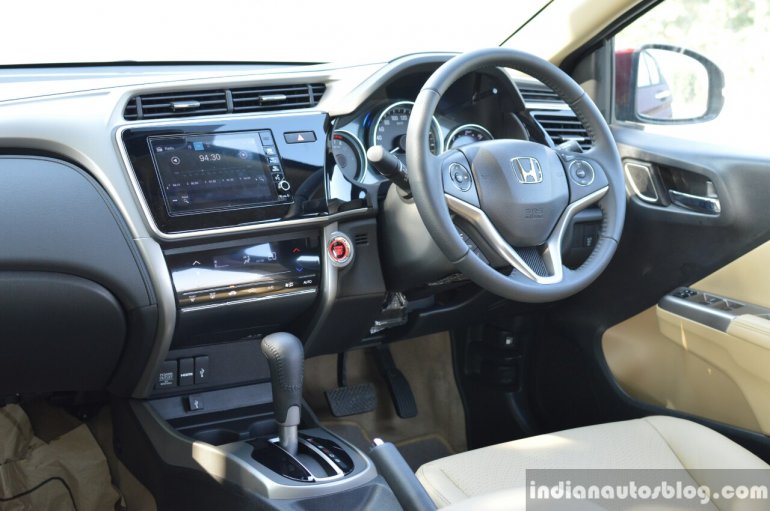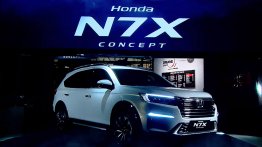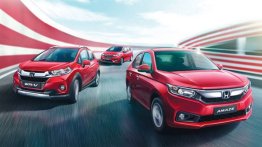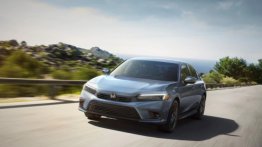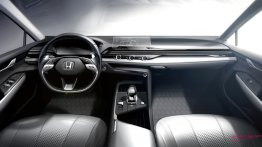Looks sharper and feels more premium than the outgoing model.
| Specifications | 2017 Honda City Petrol |
| Dimensions | |
| Overall Length (mm) | 4,400 |
| Overall Width (mm) | 1,695 |
| Overall Height (mm) | 1,495 |
| WheelBase (mm) | 2,600 |
| Fuel Tank Capacity (L) | 40 |
| Engine | |
| Displacement | 1,497 cc |
| Max Power (PS/rpm) | 119/6,600 |
| Max Torque (Nm/rpm) | 145/4,600 |
| Transmission | |
| Type | 5-Speed Manual / Earthdreams CVT |
| Fuel Economy | |
| Manual (km/L) | 17.4 |
| CVT (km/L) | 18 |
| Suspension | |
| Front | McPherson Strut with Coil Spring |
| Rear | Torsion Beam Axle with Coil Spring |
| Brakes | |
| Front | Disc |
| Rear | Drum |
| Tyres and Wheels | |
| Size | 185 / 55 R16 |
| Type | Tubeless |
Honda's bread and butter product is lately facing serious heat from rivals like the Maruti Ciaz and Hyundai Verna, both of which are due for updates this year as well. There was a time when the Honda City dominated the premium sedan segment; attracting car buyers with its strong reliability, good cabin space, sharp design, and fuel efficient line of engines.
There was a significant spike in demand for petrol variants of the City last year, which affected its monthly volumes as the Japanese manufacturer had to adjust the production mix to manage the shifting consumer preference. Another reason for the fall in demand can also be attributed to the success of its closest rival, the Maruti Ciaz, which is available with a mild-hybrid system (diesel variant) and backed by India's most comprehensive service network.
So far, the Honda City has been on the defense; fencing off competition from other mid-size sedans since its introduction in India. With the mid-cycle facelift, however, the City will turn to offense and try to retrieve the crown of best-selling sedan from the Maruti Ciaz. To find out whether the changes make the already-brilliant City better, Honda invited IndianAutosBlog to Delhi for a brief test drive post its national launch.
The mid-cycle refresh may not be as comprehensive as I had expected, but the little changes that designers have made instill a sharper look to the car. The characteristic chrome winged bar is now slimmer, sits upright and runs into the larger headlamps (a nod to the 10th gen Honda Civic), while the redesigned bumper looks sportier with more sculpted details. Other highlights of the front fascia are new pairs of LED headlamps and foglamps (standard in VX and ZX), a first-in-class feature.
VX and ZX grades ride on diamond-cut 16 inch alloy rims, which look much better than the dull 15-inch 5-spoke rims of the outgoing City. As for the rear-end, Honda has tweaked the rear bumper to match with the sporty styling of the front fascia, and City ZX buyers exclusively get LED-powered taillamps and a bootlid-mounted spoiler.
The interior is more or less identical to the outgoing City, save for few minor upgrades that uplift the premium quotient. The VX and ZX grades get soft-touch leather wrap on the dashboard, a new start/stop button with a pulsating glow (inspired by Jaguar), and an all new 17.7 cm DIGIPAD touchscreen infotainment system.
The new capacitive touchscreen system has a higher resolution display, fewer buttons, sits flush with the gloss-black center console, and runs an intuitive Android-based custom OS. It's far better to operate than the previous 6.2-inch unit, and is standard right from the mid-spec V grade. This is probably one of the best touchscreen units fitted in a car priced under INR 15 Lakhs.
Other new features include auto headlamps, rain-sensing wipers, and side+curtain airbags, although they're exclusive to the ZX grade. Combine these changes with the spacious, ergonomic cabin of the 4th gen City, and its desirability raises by a notch.
Honda has left the engine lineup and transmission options intact. The petrol variant continues with the 1.5L i-VTEC 4-cyl motor with 119 PS and 145 Nm of torque, which can be had with a 5-speed manual or CVT, and the diesel City has the same 1.5L i-DTEC 4-cyl motor paired with a 6-speed manual only, producing 100 PS and 200 Nm of twisting power.
We drove the top-end City ZX petrol, which is only available with a CVT and is claimed to be more fuel efficient than its manual counterpart (18.0 km/L > 17.4 km/L). There is no discernible differences with the predecessor's petrol CVT variant; the engine is punchy, has good levels of refinement and is a driving enthusiast's delight, but the CVT doesn't share the same enthusiasm as the i-VTEC motor.
Power delivery to the wheels may be butter smooth, but the usual quirks of a CVT are still present. To emulate the feeling of shifting through gear ratios manually, the top-end grades get steering-mounted paddle shifters. It's still the only sedan to offer flappy paddles in the segment.
The suspension package and tuning remains largely the same as its predecessor. Ride quality is pliant, offering the right balance of comfort and firmness, thus retaining one of the City's strong points. The power-assisted steering weighs up nicely at high speeds, but is not very communicative with the driver.
First Impression:
Honda has managed to maintain the familiarity of its best-selling model, whilst introducing key design changes and upgrades that give it an appeal of a new, more contemporary sedan. The INR 13.53 Lakh asking price for the City ZX petrol makes it the most expensive sedan in its class, but Honda has crammed plenty of equipment to justify the price tag. It can also be considered as their bold attempt at luring customers from base petrol variants of larger sedans like the Corolla Altis and Hyundai Elantra.
In just twelve days after bookings opened, Honda received over 5,000 orders for the new City, so it's already off to a great start. The new City will face challenging times ahead, when Maruti and Hyundai introduce the facelifted Ciaz and next generation Verna this year, respectively. But we're confident that it will put up a good fight this year, and bring the numbers Honda is looking for. It's a 'City' after all.
